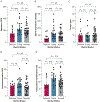Platelet Bioenergetics and Associations With Delirium and Coma in Patients With Sepsis: A Prospective Cohort Study
- PMID: 38938510
- PMCID: PMC11210717
- DOI: 10.1016/j.chstcc.2024.100076
Platelet Bioenergetics and Associations With Delirium and Coma in Patients With Sepsis: A Prospective Cohort Study
Abstract
Background: Acute brain dysfunction during sepsis, which manifests as delirium or coma, is common and is associated with multiple adverse outcomes, including longer periods of mechanical ventilation, prolonged hospital stays, and increased mortality. Delirium and coma during sepsis may be manifestations of alteration in systemic metabolism. Because access to brain mitochondria is a limiting factor, measurement of peripheral platelet bioenergetics offers a potential opportunity to understand metabolic changes associated with acute brain dysfunction during sepsis.
Research question: Are altered platelet mitochondrial bioenergetics associated with acute brain dysfunction during sepsis?
Study design and methods: We assessed participants with critical illness in the ICU for the presence of delirium or coma via validated assessment measures. Blood samples were collected and processed to isolate and measure platelet mitochondrial oxygen consumption. We used Seahorse extracellular flux to measure directly baseline, proton leak, maximal oxygen consumption rate, and extracellular acidification rate. We calculated adenosine triphosphate-linked, spare respiratory capacity, and nonmitochondrial oxygen consumption rate from the measured values.
Results: Maximum oxygen consumption was highest in patients with coma, as was spare respiratory capacity and extracellular acidification rate in unadjusted analysis. After adjusting for age, sedation, modified Sequential Organ Failure Assessment score without the neurologic component, and preexisting cognitive function, increased spare respiratory capacity remained associated with coma. Delirium was not associated with any platelet mitochondrial bioenergetics.
Interpretation: In this single-center exploratory prospective cohort study, we found that increased platelet mitochondrial spare respiratory capacity was associated with coma in patients with sepsis. Future studies powered to determine any relationship between delirium and mitochondrial respiration bioenergetics are needed.
Keywords: acute brain dysfunction; bioenergetics; coma; delirium; platelet mitochondria; sepsis.
Figures



Similar articles
-
Clinical values of cerebral oxygen saturation monitoring in patients with septic shock.Zhong Nan Da Xue Xue Bao Yi Xue Ban. 2021 Nov 28;46(11):1212-1219. doi: 10.11817/j.issn.1672-7347.2021.200905. Zhong Nan Da Xue Xue Bao Yi Xue Ban. 2021. PMID: 34911855 Free PMC article. Chinese, English.
-
Association between endothelial dysfunction and acute brain dysfunction during critical illness.Anesthesiology. 2013 Mar;118(3):631-9. doi: 10.1097/ALN.0b013e31827bd193. Anesthesiology. 2013. PMID: 23263016 Free PMC article.
-
Prevalence and risk factors for delirium in critically ill patients with COVID-19 (COVID-D): a multicentre cohort study.Lancet Respir Med. 2021 Mar;9(3):239-250. doi: 10.1016/S2213-2600(20)30552-X. Epub 2021 Jan 8. Lancet Respir Med. 2021. PMID: 33428871 Free PMC article.
-
Interventions for preventing intensive care unit delirium in adults.Cochrane Database Syst Rev. 2018 Nov 23;11(11):CD009783. doi: 10.1002/14651858.CD009783.pub2. Cochrane Database Syst Rev. 2018. PMID: 30484283 Free PMC article.
-
A clinical perspective of sepsis-associated delirium.J Intensive Care. 2016 Mar 23;4:18. doi: 10.1186/s40560-016-0145-4. eCollection 2016. J Intensive Care. 2016. PMID: 27011789 Free PMC article. Review.
Cited by
-
Impairment of platelet mitochondrial respiration in patients with chronic kidney disease with and without diabetes.Mol Cell Biochem. 2025 Aug;480(8):4745-4755. doi: 10.1007/s11010-025-05280-5. Epub 2025 Apr 12. Mol Cell Biochem. 2025. PMID: 40220191 Free PMC article.
References
-
- Sonneville R, de Montmollin E, Poujade J, et al. Potentially modifiable factors contributing to sepsis-associated encephalopathy. Intensive Care Med. 2017;43(8):1075–1084. - PubMed
Grants and funding
LinkOut - more resources
Full Text Sources
